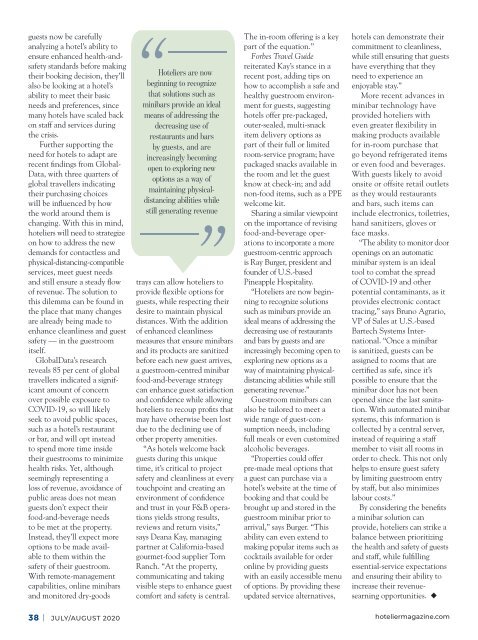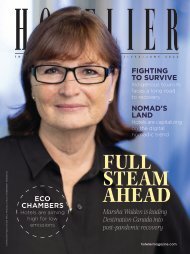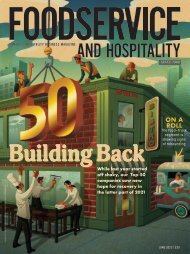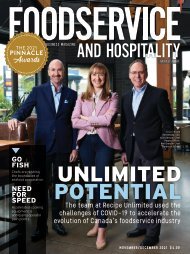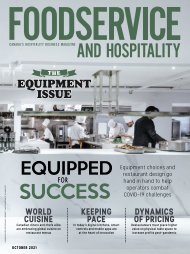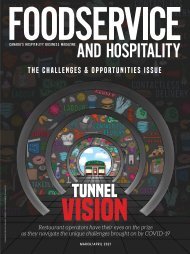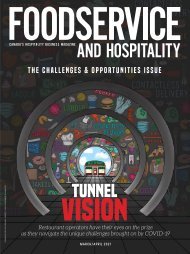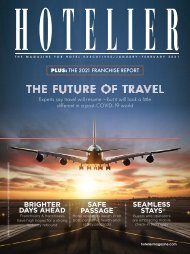July/August 2020
July/August 2020 issue of Hotelier magazine.
July/August 2020 issue of Hotelier magazine.
You also want an ePaper? Increase the reach of your titles
YUMPU automatically turns print PDFs into web optimized ePapers that Google loves.
guests now be carefully<br />
analyzing a hotel’s ability to<br />
ensure enhanced health-andsafety<br />
standards before making<br />
their booking decision, they’ll<br />
also be looking at a hotel’s<br />
ability to meet their basic<br />
needs and preferences, since<br />
many hotels have scaled back<br />
on staff and services during<br />
the crisis.<br />
Further supporting the<br />
need for hotels to adapt are<br />
recent findings from Global-<br />
Data, with three quarters of<br />
global travellers indicating<br />
their purchasing choices<br />
will be influenced by how<br />
the world around them is<br />
changing. With this in mind,<br />
hoteliers will need to strategize<br />
on how to address the new<br />
demands for contactless and<br />
physical-distancing-compatible<br />
services, meet guest needs<br />
and still ensure a steady flow<br />
of revenue. The solution to<br />
this dilemma can be found in<br />
the place that many changes<br />
are already being made to<br />
enhance cleanliness and guest<br />
safety — in the guestroom<br />
itself.<br />
GlobalData’s research<br />
reveals 85 per cent of global<br />
travellers indicated a significant<br />
amount of concern<br />
over possible exposure to<br />
COVID-19, so will likely<br />
seek to avoid public spaces,<br />
such as a hotel’s restaurant<br />
or bar, and will opt instead<br />
to spend more time inside<br />
their guestrooms to minimize<br />
health risks. Yet, although<br />
seemingly representing a<br />
loss of revenue, avoidance of<br />
public areas does not mean<br />
guests don’t expect their<br />
food-and-beverage needs<br />
to be met at the property.<br />
Instead, they’ll expect more<br />
options to be made available<br />
to them within the<br />
safety of their guestroom.<br />
With remote-management<br />
capabilities, online minibars<br />
and monitored dry-goods<br />
Hoteliers are now<br />
beginning to recognize<br />
that solutions such as<br />
minibars provide an ideal<br />
means of addressing the<br />
decreasing use of<br />
restaurants and bars<br />
by guests, and are<br />
increasingly becoming<br />
open to exploring new<br />
options as a way of<br />
maintaining physicaldistancing<br />
abilities while<br />
still generating revenue<br />
trays can allow hoteliers to<br />
provide flexible options for<br />
guests, while respecting their<br />
desire to maintain physical<br />
distances. With the addition<br />
of enhanced cleanliness<br />
measures that ensure minibars<br />
and its products are sanitized<br />
before each new guest arrives,<br />
a guestroom-centred minibar<br />
food-and-beverage strategy<br />
can enhance guest satisfaction<br />
and confidence while allowing<br />
hoteliers to recoup profits that<br />
may have otherwise been lost<br />
due to the declining use of<br />
other property amenities.<br />
“As hotels welcome back<br />
guests during this unique<br />
time, it’s critical to project<br />
safety and cleanliness at every<br />
touchpoint and creating an<br />
environment of confidence<br />
and trust in your F&B operations<br />
yields strong results,<br />
reviews and return visits,”<br />
says Deana Kay, managing<br />
partner at California-based<br />
gourmet-food supplier Torn<br />
Ranch. “At the property,<br />
communicating and taking<br />
visible steps to enhance guest<br />
comfort and safety is central.<br />
The in-room offering is a key<br />
part of the equation.”<br />
Forbes Travel Guide<br />
reiterated Kay’s stance in a<br />
recent post, adding tips on<br />
how to accomplish a safe and<br />
healthy guestroom environment<br />
for guests, suggesting<br />
hotels offer pre-packaged,<br />
outer-sealed, multi-snack<br />
item delivery options as<br />
part of their full or limited<br />
room-service program; have<br />
packaged snacks available in<br />
the room and let the guest<br />
know at check-in; and add<br />
non-food items, such as a PPE<br />
welcome kit.<br />
Sharing a similar viewpoint<br />
on the importance of revising<br />
food-and-beverage operations<br />
to incorporate a more<br />
guestroom-centric approach<br />
is Ray Burger, president and<br />
founder of U.S.-based<br />
Pineapple Hospitality.<br />
“Hoteliers are now beginning<br />
to recognize solutions<br />
such as minibars provide an<br />
ideal means of addressing the<br />
decreasing use of restaurants<br />
and bars by guests and are<br />
increasingly becoming open to<br />
exploring new options as a<br />
way of maintaining physicaldistancing<br />
abilities while still<br />
generating revenue.”<br />
Guestroom minibars can<br />
also be tailored to meet a<br />
wide range of guest-consumption<br />
needs, including<br />
full meals or even customized<br />
alcoholic beverages.<br />
“Properties could offer<br />
pre-made meal options that<br />
a guest can purchase via a<br />
hotel’s website at the time of<br />
booking and that could be<br />
brought up and stored in the<br />
guestroom minibar prior to<br />
arrival,” says Burger. “This<br />
ability can even extend to<br />
making popular items such as<br />
cocktails available for order<br />
online by providing guests<br />
with an easily accessible menu<br />
of options. By providing these<br />
updated service alternatives,<br />
hotels can demonstrate their<br />
commitment to cleanliness,<br />
while still ensuring that guests<br />
have everything that they<br />
need to experience an<br />
enjoyable stay.”<br />
More recent advances in<br />
minibar technology have<br />
provided hoteliers with<br />
even greater flexibility in<br />
making products available<br />
for in-room purchase that<br />
go beyond refrigerated items<br />
or even food and beverages.<br />
With guests likely to avoid<br />
onsite or offsite retail outlets<br />
as they would restaurants<br />
and bars, such items can<br />
include electronics, toiletries,<br />
hand sanitizers, gloves or<br />
face masks.<br />
“The ability to monitor door<br />
openings on an automatic<br />
minibar system is an ideal<br />
tool to combat the spread<br />
of COVID-19 and other<br />
potential contaminants, as it<br />
provides electronic contact<br />
tracing,” says Bruno Agrario,<br />
VP of Sales at U.S.-based<br />
Bartech Systems International.<br />
“Once a minibar<br />
is sanitized, guests can be<br />
assigned to rooms that are<br />
certified as safe, since it’s<br />
possible to ensure that the<br />
minibar door has not been<br />
opened since the last sanitation.<br />
With automated minibar<br />
systems, this information is<br />
collected by a central server,<br />
instead of requiring a staff<br />
member to visit all rooms in<br />
order to check. This not only<br />
helps to ensure guest safety<br />
by limiting guestroom entry<br />
by staff, but also minimizes<br />
labour costs.”<br />
By considering the benefits<br />
a minibar solution can<br />
provide, hoteliers can strike a<br />
balance between prioritizing<br />
the health and safety of guests<br />
and staff, while fulfilling<br />
essential-service expectations<br />
and ensuring their ability to<br />
increase their revenuesearning<br />
opportunities. ◆<br />
38 | JULY/AUGUST <strong>2020</strong> hoteliermagazine.com


